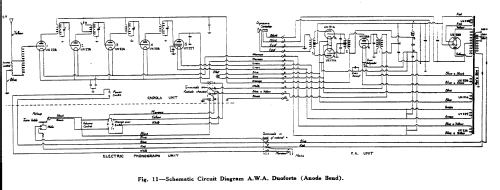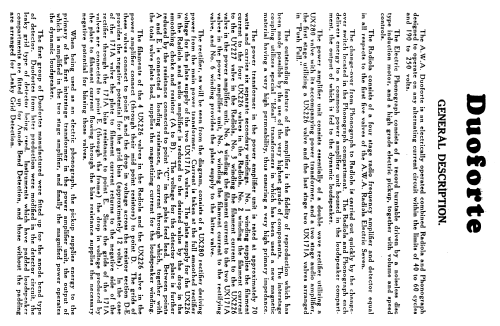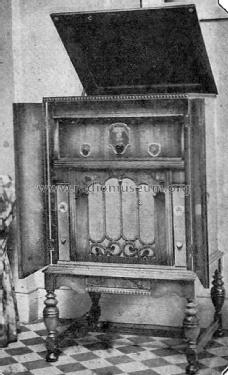Duoforte C56 Anode Bend detection
Amalgamated Wireless (Australasia) Ltd. (AWA); Sydney
- Land
- Australien
- Hersteller / Marke
- Amalgamated Wireless (Australasia) Ltd. (AWA); Sydney
- Jahr
- 1929
- Kategorie
- Rundfunkempfänger (Radio - oder Tuner nach WW2)
- Radiomuseum.org ID
- 164718
Klicken Sie auf den Schaltplanausschnitt, um diesen kostenlos als Dokument anzufordern.
- Anzahl Röhren
- 9
- Hauptprinzip
- Geradeaus ohne Rückkopplung; 2 NF-Stufe(n); Anodengleichrichtung
- Wellenbereiche
- Mittelwelle, keine anderen.
- Spezialitäten
- Plattenspieler (kein -Wechsler)
- Betriebsart / Volt
- Wechselstromspeisung / 190-250 Volt
- Lautsprecher
- Dynamischer LS, mit Erregerspule (elektrodynamisch)
- Material
- Gerät mit Holzgehäuse
- von Radiomuseum.org
- Modell: Duoforte C56 [Anode Bend detection] - Amalgamated Wireless
- Form
- Standgerät auf niedrigen Beinen (Beine < 50 % der Gesamthöhe).
- Bemerkung
-
9 Valve, AC powered, 4 stage, TRF Receiver with Anode Bend Detection and a push-pull audio Amplifier, output stage. Advertised for £125/- in May, 1929.
Chassis:
The chassis incorporates two units, a receiver and a power amplifier unit with rectifier.
The early production C56 receivers used Anode Bend Detection and the later production C56 used Leaky Grid Detection.Phonograph:
Induction, motor driven turntable with speed control, automatic stop and a Tone arm with volume control.Cabinet:
Console style cabinet with lid for the gramophone and doors on the front.
The early production Douforte C56 had a padded loudspeaker compartment.
- Literaturnachweis
- AWA service instructions, 1929
- Literatur/Schema (1)
- - - Manufacturers Literature (AWA Radiola Service Instruction 1929)
| AWA Duoforte C56 Pamplet | 1653 KB | |
| AWA Duoforte C56 Service Notes | 133 KB |
- Dokumente zu diesem Modell
- Autor
- Modellseite von Stuart Irwin angelegt. Siehe bei "Änderungsvorschlag" für weitere Mitarbeit.
- Weitere Modelle
-
Hier finden Sie 1438 Modelle, davon 884 mit Bildern und 466 mit Schaltbildern.
Alle gelisteten Radios usw. von Amalgamated Wireless (Australasia) Ltd. (AWA); Sydney



